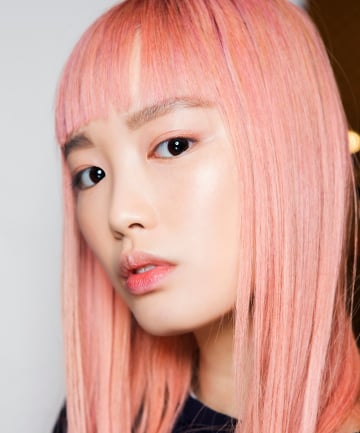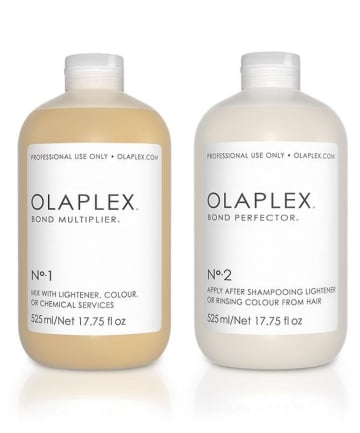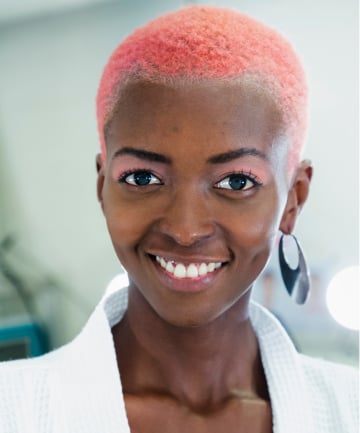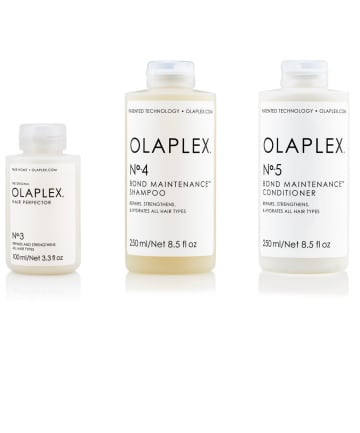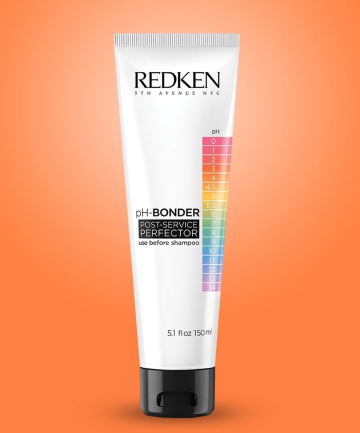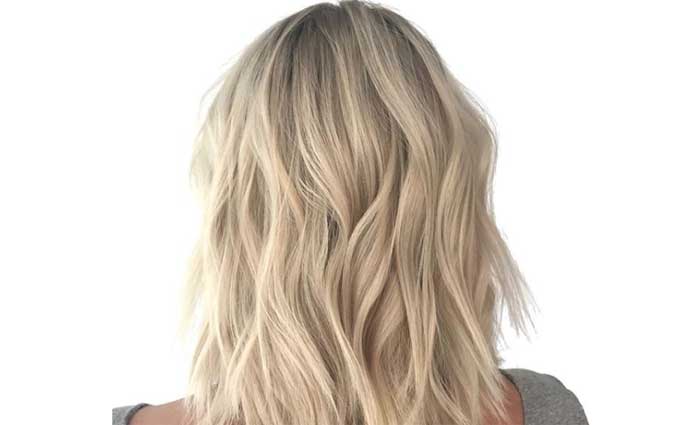To put it simply, Olaplex is a three-step system that repairs damaged hair and can help prevent future damage. Olaplex Educator Ty Render says that it "links broken disulfide bonds in the hair during and after chemical services making the bonds stronger than they were before the service." That might sound too good to be true, but it comes down to science. To prevent this from turning into chemistry class, know that the disulfide bonds are strong bonds that give hair its shape, strength and elasticity. They are some of the strongest natural bonds, but they can break from chemical, mechanical (e.g. brushing) and thermal damage. Render adds that environmental damage, hair color and our daily hair routines are all bond-breaking culprits. Olaplex uses the same patented active ingredient in all three steps of its treatment to repair said broken bonds. FYI: The Olaplex treatment doesn't contain any silicones or oils. It also won't impact existing hair color.
Creative director of Inanch London and session stylist Inanch Emir says that Olaplex seeks out the damage of these bonds and reinforces the tiny bonds. We might not be able to see the broken bonds with our naked eyes, but we will see the results of the treatment because hair will be stronger, more flexible and less prone to breakage. If you're curious, there are microscope photos to show the difference.
Image via Imaxtree
Creative director of Inanch London and session stylist Inanch Emir says that Olaplex seeks out the damage of these bonds and reinforces the tiny bonds. We might not be able to see the broken bonds with our naked eyes, but we will see the results of the treatment because hair will be stronger, more flexible and less prone to breakage. If you're curious, there are microscope photos to show the difference.
Image via Imaxtree
Who is it for?
You may have heard of Olaplex being used to prevent damage from dramatic platinum blond dye jobs or unicorn hair color. Yes, Olaplex is associated with color-treated hair, but it's not just for those looking to jump on the bleach bandwagon. Render says it's suitable for all hair textures and types, whether or not hair is colored or chemically treated. According to Brendan O'Sullivan, creative director of Brendan O'Sullivan Hair and Beauty, the treatment is particularly good on bleached hair and for clients who want to keep their long hair.
How does it work?
Olaplex is a three-step system for licensed professionals to take hair from damaged to dazzling. Helpfully, the products are named in the order they're used. The No. 1 Bond Multiplier is the liquid concentrate form, says Render. It is mixed with hair color, lightener or other chemical services to rebuild and repair the broken disulfide bonds and prevent further damage.
Next up is the No. 2 Bond Perfector. This is the cream form and it's applied to hair after rinsing color and/or shampooing lightener. It helps ensure that hair is at its best by repairing any remaining broken bonds. Finally, we come to the No. 3 Hair Perfector. This is the step to ensure clients can maintain their glossy, commercial-worthy hair at home. It's a less concentrated version of No. 2 that can be applied post-salon treatment.
Olaplex for non-chemically treated hair
Christine Neos, colorist at Eddie Arthur Salon, says that when clients want an Olaplex treatment but aren't getting their hair chemically treated, No. 1 is applied with room temperature water. No. 2 is then applied to towel-dried hair.
You may have heard of Olaplex being used to prevent damage from dramatic platinum blond dye jobs or unicorn hair color. Yes, Olaplex is associated with color-treated hair, but it's not just for those looking to jump on the bleach bandwagon. Render says it's suitable for all hair textures and types, whether or not hair is colored or chemically treated. According to Brendan O'Sullivan, creative director of Brendan O'Sullivan Hair and Beauty, the treatment is particularly good on bleached hair and for clients who want to keep their long hair.
How does it work?
Olaplex is a three-step system for licensed professionals to take hair from damaged to dazzling. Helpfully, the products are named in the order they're used. The No. 1 Bond Multiplier is the liquid concentrate form, says Render. It is mixed with hair color, lightener or other chemical services to rebuild and repair the broken disulfide bonds and prevent further damage.
Next up is the No. 2 Bond Perfector. This is the cream form and it's applied to hair after rinsing color and/or shampooing lightener. It helps ensure that hair is at its best by repairing any remaining broken bonds. Finally, we come to the No. 3 Hair Perfector. This is the step to ensure clients can maintain their glossy, commercial-worthy hair at home. It's a less concentrated version of No. 2 that can be applied post-salon treatment.
Olaplex for non-chemically treated hair
Christine Neos, colorist at Eddie Arthur Salon, says that when clients want an Olaplex treatment but aren't getting their hair chemically treated, No. 1 is applied with room temperature water. No. 2 is then applied to towel-dried hair.
The procedure
After hearing about it and looking at transformation photos on Instagram, you might be ready to get an Olaplex treatment. Olaplex Stand Alone Treatments should only be applied by a licensed professional stylist, Render says. (FYI: A Stand Alone Treatment uses No. 1 and No. 2.) Helpfully, Olaplex lists salons that offer services on its website. Note that some salons might offer Mini Treatments using just No. 2 and can be used as a manageability treatment with single-process color, direct dyes and more. Your colorist will be able to figure out the best option for your hair.
Neos recommends Olaplex treatments every six to eight weeks in the salon, along with the at-home treatment (No. 3) one to two times a week to keeps strands looking their best and to do the utmost repair.
The cost
Prices will vary by salon. Some salons will have a treatment price, which just includes No. 1 and No. 2 with the option of buying No. 3 separately. Others might include the price of No. 3 in the service. Prices can range from $30 up to $100 — and that's on top of any color or chemical treatments.
If you're wondering if Olaplex is actually worth it, Neos says, "I have seen immense improvements on hair that has been compromised due to over-processing/heat damage." Adding that continued use at home and in salon visits will maximize results.
Image via Imaxtree
After hearing about it and looking at transformation photos on Instagram, you might be ready to get an Olaplex treatment. Olaplex Stand Alone Treatments should only be applied by a licensed professional stylist, Render says. (FYI: A Stand Alone Treatment uses No. 1 and No. 2.) Helpfully, Olaplex lists salons that offer services on its website. Note that some salons might offer Mini Treatments using just No. 2 and can be used as a manageability treatment with single-process color, direct dyes and more. Your colorist will be able to figure out the best option for your hair.
Neos recommends Olaplex treatments every six to eight weeks in the salon, along with the at-home treatment (No. 3) one to two times a week to keeps strands looking their best and to do the utmost repair.
The cost
Prices will vary by salon. Some salons will have a treatment price, which just includes No. 1 and No. 2 with the option of buying No. 3 separately. Others might include the price of No. 3 in the service. Prices can range from $30 up to $100 — and that's on top of any color or chemical treatments.
If you're wondering if Olaplex is actually worth it, Neos says, "I have seen immense improvements on hair that has been compromised due to over-processing/heat damage." Adding that continued use at home and in salon visits will maximize results.
Image via Imaxtree
It wasn't that long ago that Olaplex was only available in salons. No. 1 and No. 2 are still for professional use only but hair-obsessed customers can purchase No. 3, $28, at Sephora, Olaplex.com and professional salons. To maintain locks, it's recommended you use the step once a week. If hair is damaged, use it two to three times. In all cases, apply the treatment to damp, toweled-dried hair for a minimum of 10 minutes before rinsing. Follow with shampoo and conditioner.
Speaking of lathering up, Olaplex now offers the No. 4 Bond Maintenance Shampoo, $28, and No. 5 Bond Maintenance Conditioner, $28, for at-home use, Neos says. The shampoo is color-safe, suitable for all hair types and works to repair and nourish hair. Similarly, the conditioner nourishes and relinks broken bonds for a flawless mane. Even those who have never received a professional Olaplex Stand Alone Treatment can use No. 3, 4 or 5. No. 3 "works for all hair types and on any color of hair from virgin, natural, processed, gray, to compromised and all of the above."
Speaking of lathering up, Olaplex now offers the No. 4 Bond Maintenance Shampoo, $28, and No. 5 Bond Maintenance Conditioner, $28, for at-home use, Neos says. The shampoo is color-safe, suitable for all hair types and works to repair and nourish hair. Similarly, the conditioner nourishes and relinks broken bonds for a flawless mane. Even those who have never received a professional Olaplex Stand Alone Treatment can use No. 3, 4 or 5. No. 3 "works for all hair types and on any color of hair from virgin, natural, processed, gray, to compromised and all of the above."
When something is really good, people will be searching for dupes. There are similar treatments to Olaplex for professional and at-home use. One example is Joico's K-PAK Reconstructor, a deep conditioning treatment that restores broken bonds caused by chemical services and heat styling, says Joico brand ambassador Larisa Love. Similarly, Redken offers a pH-Bonder salon treatment with a pH-Bonder Post-Service Perfector, $16, for at-home maintenance. L'Oreal Professionnel's Smartbond system is described as the "perfect complement to its colors and lighteners" and protects and fortifies hair during service. Other brands with systems include b3 Brazilian Bond Build3r and Schwarzkopf with its Fibreplex.
No matter which treatment you get, ensure that it's done by a licensed professional and do your research. Consider what other hair treatments you're getting done, maintenance, at-home care and the stylist's experience. And don't be afraid to ask questions.
No matter which treatment you get, ensure that it's done by a licensed professional and do your research. Consider what other hair treatments you're getting done, maintenance, at-home care and the stylist's experience. And don't be afraid to ask questions.


